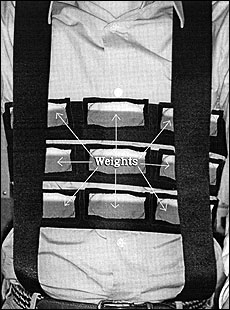Archives
Symptoms in obese may not mean asthma
Extra weight, not inflammation, may be causing airway hyperresponsiveness
By LOIS BAKER
Contributing Editor
Pulmonary researchers at UB have created asthma-like symptoms in non-asthmatic volunteers by decreasing their lung volume through simulated obesity.

Volunteers participating in the UB study wore chest vests with pockets filled with birdshot to mimic the weight distribution associated with various levels of obesity.
The study results suggest that the airway hyperresponsiveness seen in obese patients, which often leads to a diagnosis of asthma, may be treated more successfully through weight reduction than by asthma medication.
"True asthma is associated with a chronic inflammation of the airways, which makes the airways susceptible to certain triggers," said Frank J. Cerny, professor emeritus of pediatrics and exercise and nutrition sciences in the School of Public Health and Health Professions.
"We've shown that asthma symptoms seen in people who are overweight may be caused by the obesity-related increased pressure on the chest wall that reduces lung volume and alters the airways; by mechanics, in other words, rather than inflammation. This may account for the high incidence of asthma in developed nations where the incidence of obesity is epidemic."
Results of the research appeared in the September issue of Chest.
The UB study
was conducted with eight lean volunteers with a body mass index of
BMI≤25 kg/m
The study was conducted under four conditions: no intervention (normal), which served as the control condition; chest loading to simulate a BMI of around 30, considered borderline obese; thigh and calf compression to create increased lung blood volume that might be experienced at a BMI of 30; and chest loading and leg compression together.
Four volunteers also underwent chest compression equal to a BMI of 42, simulating gross obesity.
Chest loading involved wearing a vest with pockets filled with birdshot to mimic the weight distribution associated with these levels of obesity. Increased lung blood volume was simulated by using a modified anti-gravity suit similar to those worn by astronauts to prevent blood from pooling in the lower extremities during re-entry to the earth's atmosphere.
Under each study condition, volunteers received methacholine, a type of chemical in aerosol form used in airway challenge testing that produces airway constriction in persons with asthma.
Methacholine had no effect on the asthma-free participants during the control condition. However, when lung volume was reduced by chest loading, leg constriction and in combination, participants showed asthma-like symptoms. Those in the simulated BMI of 42 study had stronger reactivity.
"As the severity of simulated obesity increased, lung volume decreased and airways became hyperreactive," stated Cerny. "Decreasing lung volume upsets the regulatory mechanisms that govern the smooth muscle lining the airways and the tethers that control airway responsiveness.
"Both obesity and asthma are on the rise in developed nations and pose a major health challenge," stated Cerny. "Our study implies that, at least in some persons, the changes in airway hyperresponsiveness associated with obesity may not be asthma, which is characterized by chronic airway inflammation, but may simply reflect structural changes in the lung.
"The message to physicians is 'If you have obese patients that have asthma symptoms, it might be a good idea to get them to lose weight before putting them on medication,'" Cerny said.
Li-Ying Wang, a former UB doctoral student now at National Taiwan University, is first author on the study. Additional authors, both from UB, are Thomas J. Kufel, clinical associate professor of medicine, and Brydon J.B. Grant, professor of medicine, physiology and biophysics, and social and preventive medicine.
